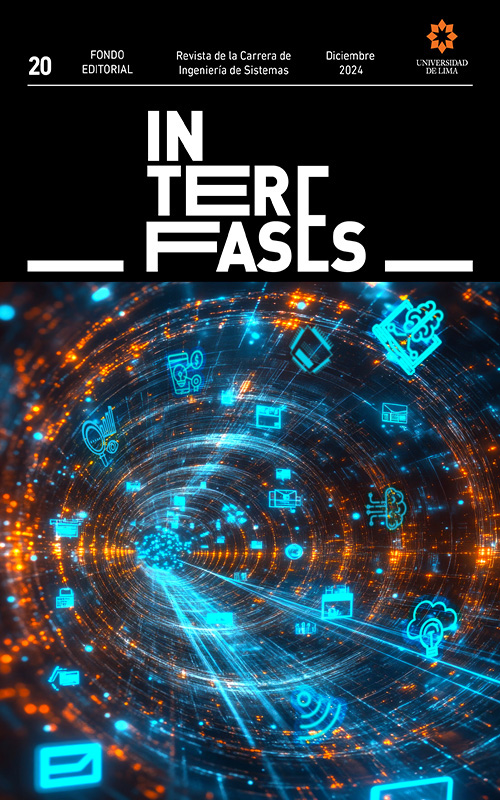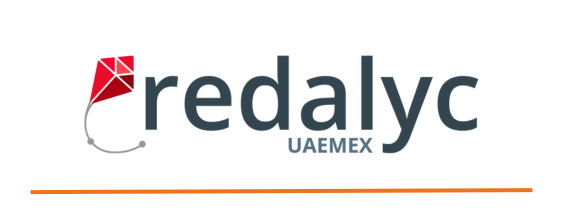Análisis del éxito académico mediante aprendizaje automático: adicción y ChatGPT
DOI:
https://doi.org/10.26439/interfases2024.n020.7390Palabras clave:
ChatGPT, adicción, aprendizaje automáticoResumen
En este trabajo, se analiza la incidencia de las variables adicción al teléfono, a la pornografía, número de veces que se desbloquea el teléfono a cada hora y nivel de confianza en ChatGPT sobre el éxito académico de un grupo de 4278 estudiantes de ocho universidades de Ecuador. Se emplean los siguientes métodos: árboles de decisión (DT), random forest (RF) y support vector machine (SVM). Los resultados obtenidos señalan niveles similares en la precisión alcanzada en los tres algoritmos, respecto a la exactitud, en caso de SMOTE, los DT son el algoritmo que presenta mayor exactitud (accuracy = 0,64); y, en el caso de RandomOverSampler, el algoritmo SVM muestra mayor exactitud (accuracy = 0,59).
Descargas
Referencias
Albalooshi, F., AlObaidy, H., & Ghanim, A. (2019). Mining students outcomes: An empirical study. International Journal of Computing and Digital Systems, 8(3), 229-241. https://doi.org/10.12785/ijcds/080303
Alghamdi, A. S., & Rahman, A. (2023). Data mining approach to predict success of secondary school students: A Saudi Arabian case study. Education Sciences, 13(3), 293. https://doi.org/10.3390/educsci13030293
Batool, S., Rashid, J., Nisar, M. W., Kim, J., Kwon, H. Y., & Hussain, A. (2023). Educational data mining to predict students’ academic performance: A survey study. Education and Information Technologies, 28, 905-971. https://doi.org/10.1007/s10639-022-11152-y
Beaulac, C., & Rosenthal, J. S. (2019). Predicting university students’ academic success and major using random forests. Research in Higher Education, 60, 1048-1064. https://doi.org/10.1007/s11162-019-09546-y
Blagus, R., & Lusa, L. (2013). SMOTE for high-dimensional class-imbalanced data. BMC Bioinformatics, 14(106), 1-16. https://doi.org/10.1186/1471-2105-14-106
Cai, Q., Lin, Y., & Yu, Z. (2023). Factors influencing learner attitudes towards ChatGPT-assisted language learning in higher education. International Journal of Human–Computer Interaction. Publicación anticipada en línea. https://doi.org/10.1080/10447318.2023.2261725
Chaudhury, P., & Tripathy, H. K. (2018). A study on impact of smartphone addiction on academic performance. International Journal of Engineering and Technology, 7(2.6), 50-53. https://doi.org/10.14419/ijet.v7i2.6.10066
Chawla, N. V., Bowyer, K. W., Hall, L. O., & Kegelmeyer, W. P. (2002). Synthetic minority over-sampling technique. Journal of Artificial Intelligence Research, 16, 321-357. https://doi.org/10.1613/jair.953
Chen, Y.-C. (2006). A study of comparing the use of augmented reality and physical models in chemistry education. VRCIA’06: Virtual Reality Continuum and Its Applications 2006, 1, 369-372. https://doi.org/10.1145/1128923.1128990
Chen, Y., & Zhai, L. (2023). A comparative study on student performance prediction using machine learning. Education and Information Technologies, 28, 12039-12057. https://doi.org/10.1007/s10639-023-11672-1
Cui, W., Sangsongfar, A., & Amdee, N. (2024). A comparative study of the applicability of regression models in predicting student academic performance. Naresuan University Engineering Journal, 19(1), 39-49. https://ph01.tci-thaijo.org/index.php/nuej/article/view/255799
Elkhodr, M., Gide, E., Wu, R., & Darwish, O. (2023). ICT students’ perceptions towards ChatGPT: An experimental reflective lab analysis. STEM Education, 3(2), 70-88. https://doi.org/10.3934/steme.2023006
ElSharkawy, G., Helmy, Y., & Yehia, E. (2022). Employability prediction of information technology graduates using machine learning algorithms. International Journal of Advanced Computer Science and Applications, 13(10), 359-367. https://doi.org/10.14569/IJACSA.2022.0131043
Estabrooks, A., Jo, T., & Japkowicz, N. (2004). A multiple resampling method for learning from imbalanced data sets. Computational Intelligence, 20(1), 18-36. https://doi.org/10.1111/j.0824-7935.2004.t01-1-00228.x
García, V., Sánchez, J. S., Marqués, A. I., Florencia, R., & Rivera, G. (2020). Understanding the apparent superiority of over-sampling through an analysis of local information for class-imbalanced data. Expert Systems with Applications, 158, artículo 113026. https://doi.org/10.1016/j.eswa.2019.113026
Gutiérrez-Aguilar, O., Huarsaya-Rodriguez, E., & Duche-Pérez, A. (2024). The mediating effect of academic performance on ChatGPT satisfaction in university students. En G. F. Olmedo Cifuentes, D. G. Arcos Avilés y H. V. Lara Padilla (Eds.), Emerging research in intelligent systems – Proceedings of the CIT 2023 (v. 2, pp. 353-365). Springer Science and Business Media Deutschland GmbH. https://doi.org/10.1007/978-3-031-52258-1_26
Hellas, A., Ihantola, P., Petersen, A., Ajanovski, V. V., Gutica, M., Hynninen, T., Knutas, A., Leinonen, J., Messom, C., & Liao, S. N. (2018). Predicting academic performance: A systematic literature review. En G. Rößling y B. Scharlau (Eds.), ITiCSE 2018 companion: Proceedings companion of the 23rd Annual ACM Conference on Innovation and Technology in Computer Science Education (pp. 175-199). Association for Computing Machinery. https://doi.org/10.1145/3293881.3295783
Hong, Y., Rong, X., & Liu, W. (2024). Construction of influencing factor segmentation and intelligent prediction model of college students’ cell phone addiction model based on machine learning algorithm. Heliyon, 10(8), e29245. https://doi.org/10.1016/j.heliyon.2024.e29245
Kovács, G. (2019). An empirical comparison and evaluation of minority oversampling techniques on a large number of imbalanced datasets. Applied Soft Computing, 83, artículo 105662. https://doi.org/10.1016/j.asoc.2019.105662
Musso, M. F., Rodríguez, C. F., & Cascallar, E. C. (2020). Predicting key educational outcomes in academic trajectories: A machine-learning approach. Higher Education, 80, 875-894. https://doi.org/10.1007/s10734-020-00520-7
Nachouki, M., Mohamed, E. A., Mehdi, R., & Abou Naaj, M. (2023). Student course grade prediction using the random forest algorithm: Analysis of predictors’ importance. Trends in Neuroscience and Education, 33, 100214. https://doi.org/10.1016/j.tine.2023.100214
Nayak, P., Vaheed, S., Gupta, S., & Mohan, N. (2023). Predicting students’ academic performance by mining the educational data through machine learning-based classification model. Education and Information Technologies, 28, 14611-14637. https://doi.org/10.1007/s10639-023-11706-8
Newaz, A., Hassan, S., & Haq, F. S. (2022). An empirical analysis of the efficacy of different sampling techniques for imbalanced classification. arXiv. Publicación anticipada en línea. https://doi.org/10.48550/arXiv.2208.11852
Sharma, N., Appukutti, S., Garg, U., Mukherjee, J., & Mishra, S. (2023). Analysis of student’s academic performance based on their time spent on extra-curricular activities using machine learning techniques. International Journal of Modern Education and Computer Science, 15(1), 46-57. https://doi.org/10.5815/ijmecs.2023.01.04
Imbalanced learn. (2014). RandomOverSampler. https://imbalanced-learn.org/stable/references/generated/imblearn.over_sampling.RandomOverSampler.html#imblearn.over_sampling.RandomOverSampler
Wainer, J. (2024). An empirical evaluation of imbalanced data strategies from a practitioner’s point of view. Expert Systems with Applications, 256, 124863. https://doi.org/10.1016/j.eswa.2024.124863
Wongvorachan, T., He, S., & Bulut, O. (2023). A comparison of undersampling, oversampling, and SMOTE methods for dealing with imbalanced classification in educational data mining. Information, 14(1), 54. https://doi.org/10.3390/info14010054
Publicado
Número
Sección
Licencia
Los autores/as que publiquen en esta revista aceptan las siguientes condiciones:
Los autores/as conservan los derechos de autor y ceden a la revista el derecho de la primera publicación, con el trabajo registrado con la licencia de atribución de Creative Commons, que permite a terceros utilizar lo publicado siempre que mencionen la autoría del trabajo y a la primera publicación en esta revista.
Los autores/as pueden realizar otros acuerdos contractuales independientes y adicionales para la distribución no exclusiva de la versión del artículo publicado en esta revista (p. ej., incluirlo en un repositorio institucional o publicarlo en un libro) siempre que indiquen claramente que el trabajo se publicó por primera vez en esta revista.
Se permite y recomienda a los autores/as a publicar su trabajo en Internet (por ejemplo en páginas institucionales o personales) antes y durante el proceso de revisión y publicación, ya que puede conducir a intercambios productivos y a una mayor y más rápida difusión del trabajo publicado (vea The Effect of Open Access).
Última actualización: 03/05/21






